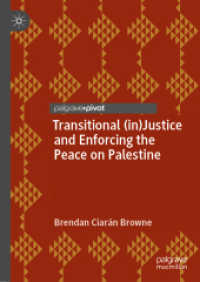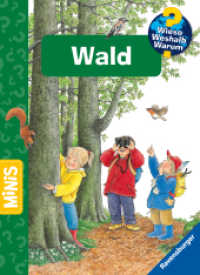Full Description
Corpus-Based Approaches to ELT presents a compilation of research exploring different ways to apply corpus-based and corpus-informed approaches to English language teaching. Starting with an overview of research in the field of corpus linguistics and language teaching, various scenarios including academic and professional settings, as well as English as International Language, are described. Corpus-Based Approaches to ELT goes on to put forward several chapters focusing on error analysis using learner corpora and comparable native speaker corpora. Some of these chapters use translations and their original sources, while others compare the production of learners from different L1 in multilingual learner corpora. Also presented are new tools for corpus processing: a query program for parallel corpora, and the provision of tools to implement pedagogical annotation. The last section discuss the challenges and opportunities that multilayered and multimodal corpora may pose to corpus linguistic investigation.
This book will be indispensible to those teaching in higher education and wishing to develop corpus-based approaches, as well as researchers in the field of English Language Teaching.
Contents
I. Corpus Linguistics and ELT: State of the Art; 1. Introduction to Corpus Linguistics and ELT (the editors); 2. Using general and specialised corpora in language teaching: Past, present and future, Ute Romer (University of Michigan, USA); II. Corpora and English for Specific Purposes; 3. Using corpora to teach academic writing, Annelie Adel (Goteborg University, Sweden); 4. "I sort of feel like, um, I want to, agree with that for the most part...": Reporting Intuitions and Ideas in Spoken Academic Discourse, Begofia Belles-Fortufio (Universitat Jaume I, Spain) and Mari Carmen Campoy (Universitat Jaume I, Spain); 5. Hong Kong engineering corpus: empowering professionals-in-training to learn the language of their profession, Winnie Cheng (Hong Kong Polytechnic University, Hong Kong); 6. Analysis of organising and rhetorical lexical items in a learner corpus of technical writing, Maria Jose Luzon Marco (University of Zaragoza, Spain); 7. A corpus-informed approach to teaching lecture comprehension skills in English for Business Studies, Belinda Crawford Camiciottoli (University of Florence, Italy); 8. Creating a corpus of EIL cross-cultural interaction in the public domain, Maria Georgieva (Sofia University, Bulgaria) and Lilyana Grozdanova (Sofia University, Bulgaria); III. Learner Corpora and Corpus-Informed Teaching Materials; 9. Spoken learner corpora and EFL teaching, Sylvie De Cock (Universite Catholique de Louvain, France); 10. Designing and exploiting a small online English-Spanish parallel corpus for language teaching purposes, Julia Lavid (Universidad Complutense de Madrid, Spain), Jorge Anus (Universidad Complutense de Madrid, Spain) and Juan Rafael Zamorano (Universidad Complutense de Madrid, Spain); 11. English phrasal verbs: A usage-based approach to L2 acquisition, Rafael Alejo (Universidad de Extremadura, Spain); 12. Analysing EFL learner output in the MiLC project: An error it's*, but which tag?, Ma Angeles Andreu Andres, Aurora Astor Guardiola, Maria Boquera Matarredona, Penny Macdonald, Begotia Montero Fleta and Carmen Perez Sabater (Universitat de Polifecnica Valencia, Spain); 13. Focus on errors: Learner corpora as pedagogical tools, Amaya Mendikoetxea, Susana Murcia and Paul Rollinson (Universidad Autonoma de Madrid); 14. The monolingual learners' dictionary as a productive tool: The contribution of learner corpora, Magali Paquot and Sylvie De Cock (Universite Catholique de Louvain, France); 15. Incorporating learner corpora data in grammar teaching, Tom Rankin (Vienna University of Economics and Business Administration, Austria); 16. FL students' input in EAP courses in higher education: Corpus methodology for implementing language representativeness, Izaskun Elorza (Universidad de Salamanca, Spain) and Blanca Garcia-Riaza (Universidad de Salamanca, Spain) IV. Multimodality: Corpus Tools and Language Processing Technology; 17. A Generic Tool For Annotating TEI-Compliant Corpora, Jose Maria Alcaraz, Pascual Perez-Paredes, and Encarnacion Tornero (Universidad de Murcia, Spain); 18. Translation and language learning: AlfraCOVALT as a tool for teaching pragmatics in an EFL context, Josep Roderic Guzman (Universitat Jaume I, Spain) and Eva Alcon (Universitat Jaume I, Spain); 19. The videocorpus as a multimodal tool for teaching, Inmaculada Fortanet-Gomez (Universitat Jaume I, Spain) and Mercedes Querol-Julian (Universitat Jaume I, Spain); Bibliography; Index.








